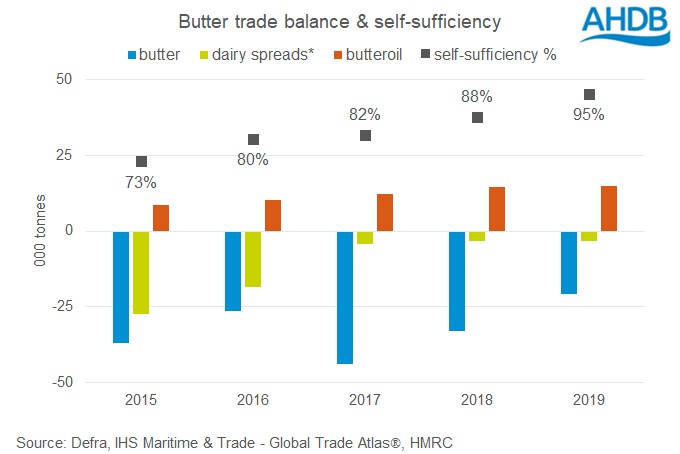Butter self-sufficiency in the UK
Wednesday, 18 November 2020
By Patty Clayton
The UK has historically had a trade deficit in butter, although this has been declining in recent years. Investments in production capacity in the past five years have meant larger volumes have been produced domestically, displacing some imports.
As of 2019, the UK had reached 95% self-sufficiency for butter overall, having risen steadily since 2015. The overall butter market can be split into three key product categories; butter, dairy spreads and butteroils[1]. Production data is not split out by categories, meaning we can’t determine the self-sufficiency of each product type. We can however look at trends in the balance of trade to give an idea of where we are making advances in self-sufficiency.
For butter, the UK continues to be a net importer, although the trade deficit is dropping. The largest deficit occurs in our trade with Ireland, where we have imported about six times as much butter as we’ve export on average in the past five years. We also run a large deficit with Denmark, which will be partly due to imports of branded Lurpak butter.

The trade deficit in dairy spreads has also declined in recent years, with a step change occurring in 2017. Since then, the deficit has remained steady at around 3k-4k tonnes per year. It must be pointed out that these figures do not include all imports of dairy spreads as some are known to be recorded in the trade statistics under a mixed ‘food preparations’ code. We estimate that an additional 45k to 50k tonnes of dairy spreads arrive under this code per year, substantially increasing our trade deficit in this category
For butteroils, the UK has a trade surplus, which has been gradually increasing over the past 5 years. The EU is the main destination for this product, with increasing volumes sent to the Netherlands and Italy.
[1] Butter includes bulk and packet butter (min 82% butterfat). Dairy spreads include those which contain between 40 to 80% butterfat. Butteroil includes any fats and oils derived from milk containing in excess of 99% fat such as ghee
Sign up to receive the latest information from AHDB.
While AHDB seeks to ensure that the information contained on this webpage is accurate at the time of publication, no warranty is given in respect of the information and data provided. You are responsible for how you use the information. To the maximum extent permitted by law, AHDB accepts no liability for loss, damage or injury howsoever caused or suffered (including that caused by negligence) directly or indirectly in relation to the information or data provided in this publication.
All intellectual property rights in the information and data on this webpage belong to or are licensed by AHDB. You are authorised to use such information for your internal business purposes only and you must not provide this information to any other third parties, including further publication of the information, or for commercial gain in any way whatsoever without the prior written permission of AHDB for each third party disclosure, publication or commercial arrangement. For more information, please see our Terms of Use and Privacy Notice or contact the Director of Corporate Affairs at info@ahdb.org.uk © Agriculture and Horticulture Development Board. All rights reserved.

